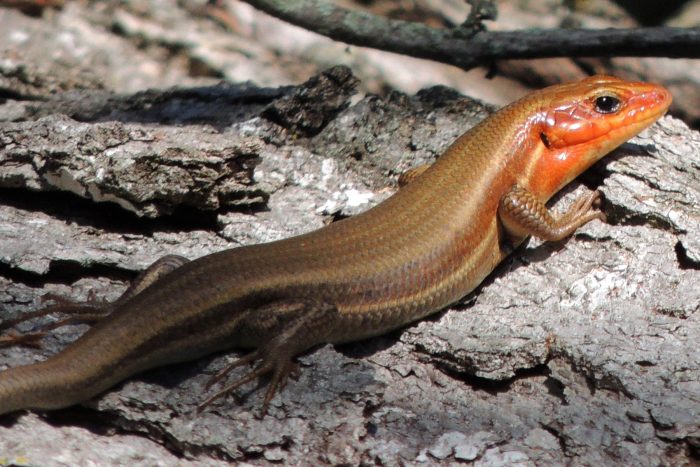Broad-Headed Skink
Plestiodon laticeps
The broad-headed skink is the largest skink in the Chesapeake Bay region. It gets its name from the large, swollen jowls males develop as they mature.
This section shows one large critter image at a time. Use the thumbnails that follow to select a specific image to display here.

This gallery contains a grid of small thumbnails. Selecting a thumbnail will change the main image in the preceding section.
Appearance
Broad-headed skinks are the largest skinks in the Chesapeake region. They range from six to 13 inches in length, and the males are larger than the females. Juveniles are dark brown to black with five cream to orange stripes running the length of their bodies. They have vibrant blue tails.
Adult broad-headed skinks generally fade to a uniform olive-brown and lost their blue tails, but females may retain their stripes. Males develop swollen jowls and heads that become a bright orange-red when breeding.
Broad-headed skinks look very similar to their cousins, five-lined skinks, and must be examined up close to determine the species. Broad-headed skinks have an enlarged row of scales under their tails and five labial scales along their upper lip (between their nose and eye).
Feeding
Broad-headed skinks eat mainly insects, spiders and other invertebrates, but will also eat mollusks, rodents and small reptiles, including juveniles of their own species. They find food through visual and chemical signals which they can detect by flicking their tongues.
Predators
Predators include birds, large reptiles and some mammals. Skinks have tails that can break away when they’re grabbed by predators. The wiggling of the detached tail can then distract the predator, giving it a chance to escape. They also escape predators by climbing trees, swimming or hiding under debris.
Reproduction and life cycle
Broad-headed skinks breed once a year in June or July. Females look to mate with large males with the brightest orange heads. Males are very territorial during breeding; a male will guard a female for about a week after mating to prevent another male from mating with her, aggressively fighting any males that approach.
Females nest in areas with plenty of dead or decaying wood, branches and leaves. Their nests are made of leaf debris or are located in a decaying tree and contain eight to thirteen eggs. A female remains with the eggs for three to eight weeks, circling the nest with her body to protect it and only leaving to feed. She stays with the eggs until they hatch usually in September, and then she leaves. Young broad-headed skinks remain in the nest for a few day before leaving.
In the northern parts of their range, broad-headed skinks hibernate from October to March. It is not known what the lifespan of a broad-headed skink is in the wild. A similar species, the five-lined skink, lives for about four years in the wild, and it’s assumed that broad-headed skinks live about as long.
Did you know?
- The broad-headed skink, or Plestiodon laticep, was formerly classified as Eumeces laticeps.
- Laticepes is derived from the Latin word latus meaning “broad” and the suffix ceps meaning “head.”
- Broad-headed skinks are diurnal (active during the day) and solitary animals.
- The broad-headed skink is the second largest skink. Only the Great Plains skink, found in the southwest, is larger.
- Broad-headed skinks are also known as “red-headed scorpions.”
Sources and additional information
- Field Guide to Maryland’s Lizards – Department of Natural Resources
- Animal Diversity Web – University of Michigan Museum of Zoology
- Reptiles and Amphibians of Eastern/Central North America – Peterson Field Guides
- Broadhead Skink – Savannah River Ecology Lab
- Broad-headed Skink – Virginia Herpetological Society
